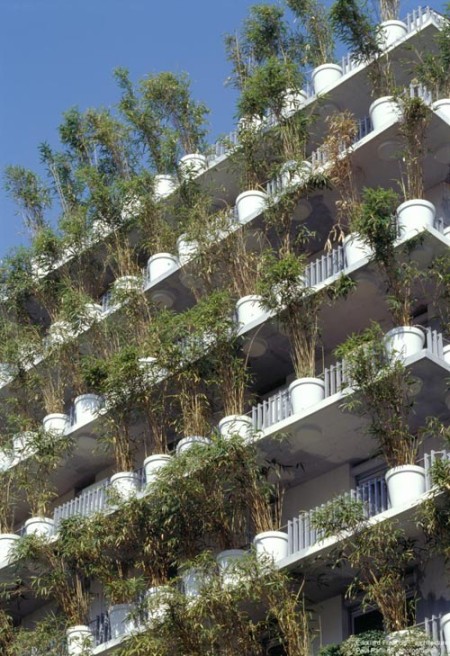At first glance, the new 10-story apartment complex in Paris known as the Flower Tower looks like a giant display of potted plants, or perhaps the work of a gardening enthusiast gone mad.
A "vertical garden" of bamboo plants sprouts from more than 400 concrete pots that line the balconies on three sides of the 28,000-sf building.
The blossoming bamboo, which will grow to a height of 12–15 feet, conceals a monolithic white-and-gray concrete structure that houses 30 apartment units and three below-grade parking levels. The greenery diffuses light and heat for the tenants and differentiates the building from the 20 or so surrounding apartment blocks of similar scale and mass.
Completed last June, the structure is part of a subsidized housing complex developed by the city's Public Office of Installation and Construction in the 17th arrondissement, a predominantly high-end residential and commercial district in the northwest reaches of Paris. Each apartment block was designed by a well-known architect, and each is arranged around a central landscaped courtyard.
The Flower Tower is the most eccentric of the lot. Its offbeat design is a reflection of the gardener inside many Parisians, says its local design architect, Edouard François, who has long observed how Parisians will cultivate even the tiniest balconies with potted plants in a brave effort to infuse nature into the dense, urban environment.
"Almost every balcony is planted," says François. "They filter the city to escape it, to establish distance from it, and to minimize its density."
The problem, François observed, was that most residential balconies are not equipped to support such plantings. Very few have water-supply spigots or ample space to maintain healthy plants, he says.
François's plan for the complex provides permanent planting pots with a built-in, automatic irrigation and fertilizing system. PVC tubing 30mm in diameter concealed within the balcony railings delivers fresh water and nutrients to the meter-tall flowerpots, which are firmly entrenched into the concrete balcony floors (see diagram, page 46). The fertilizer is added to the water in a basement storage tank and the solution is pumped up to the nine balconies. The result is a self-sustaining bamboo garden.
François says he originally desired very rare white bamboo ("one of the three rarest bamboo species in the world") for its white-gray vegetation to match the color of the surrounding concrete buildings. Instead, a species of green bamboo was selected to meld with the adjacent gardens. He says the color and volume of the bamboo will remain constant throughout the year. For variety, François added blue-violet ipomées, a seasonal flower that opens during the day and closes at night, to the pots.
Concrete-centric
Beyond the tropical foliage, the building is almost entirely concrete. Floors, walls, and ceilings are all exposed concrete. A central spiral staircase is also concrete. Even the flowerpots and balcony balustrades are concrete. Other than the steel rebar reinforcement in the exposed concrete, the building has very few structural steel components.
The flowerpots and balustrades are made of a unique concrete mix, called Ductal, that contains tiny metallic or organic fibers, silica fume, mineral fillers (nanofibers), and superplasticizer mixed with traditional concrete ingredients: cement, water, and sand. The result is a concrete that is strong (compressive strength: 30,000 psi, flexural strength: 6,500 psi) and light and does not require steel reinforcement.
Manufactured by Paris-based Lafarge Corp., Ductal also allows for the production of thin parts and smooth finishes. A combination of these traits was the key factor to the Building Team's selection of Ductal, even though the material is more expensive than conventional concrete products, says François. The project called for 35 cubic meters of Ductal to form the flowerpots and railings, which were cast offsite and installed by local contractor Léon Grosse Entreprise.
The building's cloud-like exterior walls are composed of a palette of white and gray concrete that was poured in place at the job site. The Building Team specified two concrete products — a bright-white formulation from France and a gray mix from Belgium — that would not blend when poured into the forms. "The walls were poured completely randomly," says François. "Some trucks would get on site with white concrete, others with regular gray concrete." This process had the effect of creating a two-toned "fuzzy" look, says the designer.
As for the interior spaces, there's nothing lavish about them. The building's narrow circulation core is predominantly exposed concrete, with the exception of black-and-white floor tile in the ground-level entry corridor. Inside the flats, kitchens, living rooms, and bedrooms abut the balconies to maximize daylight and introduce views of the bamboo and internal courtyard. The living spaces are free of columns, creating an open, flexible plan. Structural support is provided at the perimeter wall of each unit.
Parisians have flocked to the Flower Tower, making it one of the hottest addresses in the 17th. The building was fully occupied within a month of its opening.
Francois says residents have been pleased with the experience of being "sheathed in nature" and love the noise the bamboo makes in the wind. One tenant told him that in the summer, with the windows open and the breeze flowing through the bamboo's grassy stalks, the effect is soporific, like sleeping in a tree.







